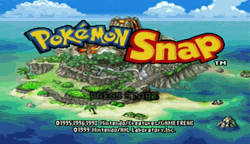 Pokémon Snap doesn’t get enough credit for being the only Pokémon game that matters.
Pokémon Snap doesn’t get enough credit for being the only Pokémon game that matters.
Pokémon Snap was not always a Pokémon game. It apparently started its time well before the release of the Nintendo 64 as “Jack and the Beanstalk”, a game that does not, in any perceptible way, exist. Was it intended as another Mario 64-esque platformer? A beanstalk-explorer like Ocarina of Time? Or was it actually some manner of JRPG? That last choice might be the most accurate, as, apparently, features from Jack and the Beanstalk were eventually integrated into the N64 release of Mother 3… which was then also scrapped. However, we do know that the original Jack and the Beanstalk did involve photography, as Iwata once confessed that Snap’s ancestor did allow the player to take pictures, but nobody could figure out why the player would take pictures. Yes, in the days before camera phones, selfies, and a built-in screenshot button, it was assumed that someone wouldn’t take random pictures if they didn’t have to (Final Fantasy 15 would be a very different game with this philosophy). What was the solution? Add something people actually liked looking at! Pokémon! Yes, Pikachu is on everything, so why not capture him on film instead of in a pokéball? He’d probably be happier that way…
So Pokémon Snap was designed around taking pictures of “peaceful” Pokémon, and not the pocket monsters that constantly assault young children scampering through tall grass. This, bizarrely, transforms the game into a first person shooter. You’re stuck on (literal) rails behind the eyes of Todd Snap, a kid who has been conscripted into a photographic war that vaguely resembles Disney Land rides. Todd must take the best pictures of Pokémon possible, and, while this is supposed to be a serene environment, he’s often asked to hurl apples and smoke bombs in the name of that perfect shot. Yes, Todd, we all believe that you beaned that Diglett into catalepsy because you were trying to feed the little critter. But, even with the nonlethal ammunition, the entire experience seems a lot closer to Doom than Pokémon Red or Pokémon Stadium. Even ignoring the lack of critter kidnapping, this is a very different Pokémon game.
And, in 1999, that is exactly what the franchise needed.
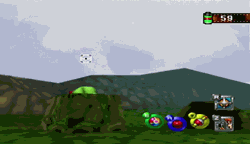 Gamers almost always, as a rule, ignore tie-in media and how it impacts their favorite games. Many of Mario’s biggest fans grew up with the Super Mario Bros. Super Show, and now publicly disavow any knowledge of that time Luigi was cursed by Mario’s errant copy of the Necronomicon, and Elvira, Mistress of the Dark, had to be summoned to purify our favorite plumber. That is not canon. Nor is it canon that Link frequently uttered “excuse me, princess” while palling around with a surprisingly horny fairy. And Mega Man certainly was never green (unless he was equipped with Leaf Shield) and was never transformed into a robot caveman. Cartoon tie-ins (and their brethren: cereal, toys, and all other kinds of merchandise) are to be considered completely non-canon. And nothing much about that has changed in the years since Captain N. Yes, Persona and Blazblue have their own modern animes, but they’re wholly useless, as they just rehash the already robust story modes of their respective games. It’s cool to see Yukiko in full animated regalia, but it’s an experience just as empty as watching Mortal Kombat: Defenders of the Realm. Actually, at least MK:DotR had the decency to include original content to sate an appetite for stories…
Gamers almost always, as a rule, ignore tie-in media and how it impacts their favorite games. Many of Mario’s biggest fans grew up with the Super Mario Bros. Super Show, and now publicly disavow any knowledge of that time Luigi was cursed by Mario’s errant copy of the Necronomicon, and Elvira, Mistress of the Dark, had to be summoned to purify our favorite plumber. That is not canon. Nor is it canon that Link frequently uttered “excuse me, princess” while palling around with a surprisingly horny fairy. And Mega Man certainly was never green (unless he was equipped with Leaf Shield) and was never transformed into a robot caveman. Cartoon tie-ins (and their brethren: cereal, toys, and all other kinds of merchandise) are to be considered completely non-canon. And nothing much about that has changed in the years since Captain N. Yes, Persona and Blazblue have their own modern animes, but they’re wholly useless, as they just rehash the already robust story modes of their respective games. It’s cool to see Yukiko in full animated regalia, but it’s an experience just as empty as watching Mortal Kombat: Defenders of the Realm. Actually, at least MK:DotR had the decency to include original content to sate an appetite for stories…
But there’s a reason Pokémon: The Animated Series blazed the trail for the “anime invasion” of the early 21st Century. You could claim it was simply its easy to understand, but robust story. You could claim it was the generally gorgeous animation (for, ya know, the late 90’s). You could even claim it was just a matter of good ol’ Pikachu being as cute as a button. But all that is secondary to the real reason Pokémon: The Adventures of Ash Ketchum and That One Squirtle was good: it took the concept of Pokémon Red/Blue and made it real. Let’s be honest here: Pokémon Red/Blue (and Green?) is an extremely limited experience. You find monsters, you catch monsters, you fight monsters against monsters. The end. There’s an overarching plot, and there’s an evil organization of propulsion-based baddies out there to defeat, but the world of Pokémon Red/Blue is otherwise very… sparse. Psyduck might have an interesting pokédex entry about lulling opponents into a false sense of security with its odd expressions, but it’s effectively the same as any other random water Pokémon in a battle. And battles are all you have!
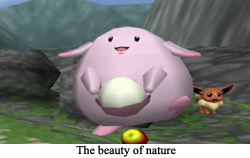 But that’s the rub about Pokémon Red/Blue, the iconic pokédex (which appears to be some kind of magical, hand-written encyclopedia in the original game) tells a tale about a much more interesting world of magical creatures. Marowak throws its bone like a boomerang. Jynx starts dance parties with its mighty hips. Porygon can live in the internet at will. Lapras was hunted to extinction by previous generations. Hell, the very concept of a “legendary” Pokémon barely exists in the gameplay of the original game. The super birds are just randomly found in caves (and one power plant), but their pokédex entries claim they are mythical monsters that appear before the damned (which, granted, is probably the natural outcome of encountering a creature that can capriciously summon lightning). There are oodles of lore, both magical and mundane, relayed through the pokédex, but absolutely none of it appears in the game proper. If you ever wanted to see a herd of Pikachu in the forest, or a Cubone gently weeping from behind its skull mask (you monster), you needed to look elsewhere. You needed to look to the Pokémon official anime.
But that’s the rub about Pokémon Red/Blue, the iconic pokédex (which appears to be some kind of magical, hand-written encyclopedia in the original game) tells a tale about a much more interesting world of magical creatures. Marowak throws its bone like a boomerang. Jynx starts dance parties with its mighty hips. Porygon can live in the internet at will. Lapras was hunted to extinction by previous generations. Hell, the very concept of a “legendary” Pokémon barely exists in the gameplay of the original game. The super birds are just randomly found in caves (and one power plant), but their pokédex entries claim they are mythical monsters that appear before the damned (which, granted, is probably the natural outcome of encountering a creature that can capriciously summon lightning). There are oodles of lore, both magical and mundane, relayed through the pokédex, but absolutely none of it appears in the game proper. If you ever wanted to see a herd of Pikachu in the forest, or a Cubone gently weeping from behind its skull mask (you monster), you needed to look elsewhere. You needed to look to the Pokémon official anime.
And, eventually, you could look to the first game that involved Pokémon being Pokémon: Pokémon Snap.
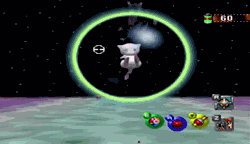 Yes, Pokémon Snap has very different gameplay from other Pokémon games. But, more importantly, it allows its Pokémon to be divorced from their usual game-based battles, and lets Pokémon just be… Pokémon. Pikachu is allowed to scamper and surf around. Gyarados is free to swim up waterfalls with impunity. And events that could only occur thanks to a boring “level up” in the “real” games are free to happen as nature intended. Magnemites gather in a trio to form a Magneton, and Slowpoke fishes up a Shellder to become Slowbro. These are all events and behaviors outlined or implied in the greater lore, but never given a chance to breathe thanks to the gameplay being entirely monster violence based.
Yes, Pokémon Snap has very different gameplay from other Pokémon games. But, more importantly, it allows its Pokémon to be divorced from their usual game-based battles, and lets Pokémon just be… Pokémon. Pikachu is allowed to scamper and surf around. Gyarados is free to swim up waterfalls with impunity. And events that could only occur thanks to a boring “level up” in the “real” games are free to happen as nature intended. Magnemites gather in a trio to form a Magneton, and Slowpoke fishes up a Shellder to become Slowbro. These are all events and behaviors outlined or implied in the greater lore, but never given a chance to breathe thanks to the gameplay being entirely monster violence based.
And, ultimately, this is why Pokémon Snap doesn’t need a sequel (though, let’s be clear, I would jump on such a thing immediately). What’s important about Pokémon Snap isn’t beanstalks, photography, or its gameplay, it’s that the world of Pokémon was finally fully realized in its proper, digital format. Taking random cues equally from Pokémon Red/Blue as the Pokémon television series, Pokémon Snap took the Pokémon franchise into a direction that allowed its monsters to be more than movelists. Yes, a thunder stone will evolve Pikachu, but wouldn’t you rather see Pika play with some berries? Maybe, maybe not, but what’s important is that Pokémon Snap created a world where that was possible. And that world…
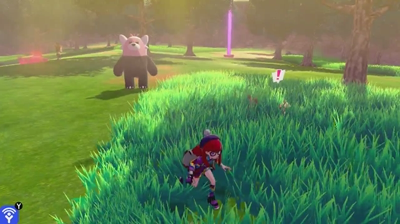
Is now the world we live in…
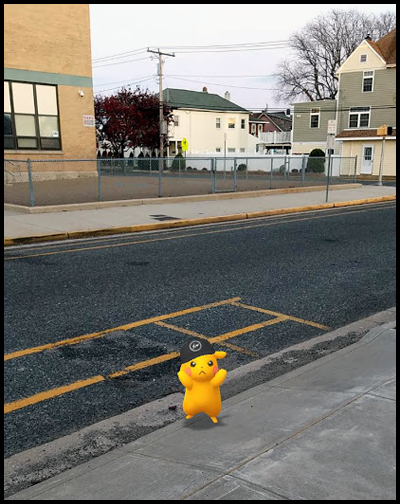
In more ways than one.
Pokémon Snap was the first Pokémon game to truly explore the world of Pokémon. And that matters.
FGC #464 Pokémon Snap
- System: Nintendo 64 for the initial release, but also eventually available for Wii and WiiU. I highly recommend the latter versions, as the N64 is unpleasant to look at.
- Number of players: Sorry, my dude Todd rides alone.
- Wasn’t Hey You, Pikachu the first real Pokémon spin-off? I didn’t say it wasn’t. It was just not at all important to anyone but microphone enthusiasts. Didn’t Alakazam own a shop in that thing? Non-canon.
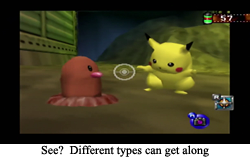 Not Canon: The three legendary birds hatch from eggs found around the various environments. But everyone knows legendary Pokémon don’t hatch from random eggs! They are summoned by Lord Arceus in a grand and unerringly confusing ceremony that takes place on a sacred mountaintop. And then they hatch from eggs! But smaller eggs! I think!
Not Canon: The three legendary birds hatch from eggs found around the various environments. But everyone knows legendary Pokémon don’t hatch from random eggs! They are summoned by Lord Arceus in a grand and unerringly confusing ceremony that takes place on a sacred mountaintop. And then they hatch from eggs! But smaller eggs! I think!- Make it a Blockbuster Night: I still have the original manual and insert that advertises how you can take your Pokémon Snap cartridge to Blockbuster Video to print out poképhotos. When Snap was rereleased on Wii/WiiU, it changed this functionality to online sharing. And that’s great, but looks like I still have to go to Blockbuster to hang these gorgeous polygons on my wall.
- Favorite Pokémon (this game): Magikarp appears in more stages than Pikachu, so it is clearly the MVP of the event. And it only gets to evolve into a Gyarados in its final appearance. What a little trooper!
- An end: Your reward for completing all the (relevant) tasks is an opportunity to float above the clouds and photograph the mythical Mew. And that’s right about when the game just wholesale turns into Killer 7, as you have to “pester” Mew into losing its shield, and then take photos of the naked genetic Pokémon. It’s an odd choice, particularly given the whole “cloud” area would be the perfect opportunity to involve other flying/fascinating Pokémon. Also, harassing Mew is just plain mean.
- Did you know? A mere 63 Pokémon appear in this adventure, despite the fact that the entire goal of the franchise is “catching ‘em all”, which, at this point, was a measly 151 Pokémon. This is likely the result of Pokémon Snap being demoted from its original position on the doomed 64DD expansion, and not at all an intentional slight against my man Drowzee.
- Would I play again: Maybe for a level or two. Pokemon Snap requires a lot of “grinding” to gain the more useful items (it’s a good way to get extra play out of a game with only seven short levels), but replaying stages with everything available is rather enjoyable. I wouldn’t say no to a portable version that already has a flute unlocked…
What’s next? Random ROB has chosen… Tetrisphere for the N64. It’s like Tetris, but round! Please look forward to it!
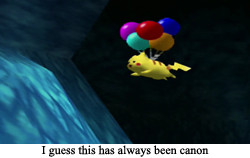
63 Pokémon out of the original 151, and like four of ’em are only present as stuff like rock formations and shadows. A constellation in the shape of Mewtwo’s official art is like the Yoshi planetoid/save icon in Super Mario Galaxy, or Peach’s Boo mask and Blooper fan in Super Mario Odyssey’s Bowser Kingdom, in that Mewtwo (and Yoshi) (and Boo and Blooper) are there, but not really THERE.
What I’m saying is taking a photo of a REAL Giant Enemy Crab would’ve been far more exciting than snapping a pile of rocks shaped like one.
That said, in retrospect I’m impressed that Pokémon Snap got even just 2/5ths of the original Gen 1 Pokédex accounted for. That’s a lot of modeling and rigging work.
Some people may give Game Freak shit for Gen 8 not even having half of all existing Pokémon in it, but frankly it was a miracle we even got seven generations’ worth of monsters in the 3DS games. Now Game Freak has to deal with the new (to them) challenge of making their Pokémon games in HD from here on out, the Switch taking them out of their GameCubesque fidelity comfort zone.
Low budget 2D platformers like Tembo and Giga Wrecker barely count as HD game development, so I’m more understanding of GF’s growing pains. I still remember being surprised when we got the luxury of animated Pokémon in Gen 5.
Really though, I’m just used to not all the Pokémon being there ‘cuz that’s happened in spinoffs (like Snap) all the dang time.
[…] years of waiting, Nintendo and/or Pokémon Company finally decided to release a new Pokémon Snap title. The appropriately titled New Pokémon Snap is, naturally, an all-new adventure that allows […]
[…] that is still ridiculously profitable popular to this day! And, while there had been a number of auxiliary Pokémon games capitalizing on the original 151 Pokémon, this was the first “new generation” ever for this […]